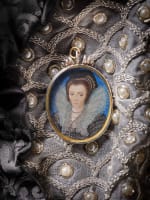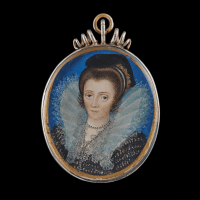

Attributed to Rowland Lockey
(c. 1565–1616) Lady Anne Cobham (d. 1612) wearing embroidered black and gold dressProvenance
Mrs P. B. K. Daingerfield of Baltimore Collection;
Sotheby’s, London, 9 February 1961, lot 24 (as a Lady, called Lady Cobham, by Hilliard);
Edward Grosvenor Paine (1911– 1989) Collection, New Orleans, La., inv. no. 186; Christie’s, London, 20 March 1989, lot 161 (as Lady Cobham by Rowland Lockey);
With D. S. Lavender (Antiques) Ltd., in 2000 (as Anne, Wife of Sir Henry Cobham by Rowland Lockey);
The Collection of the late Mrs. T. S, Eliot, Christie’s, London, 20 November 2013, lot 88 (as Anne Cobham née Sutton (d. c. 1612));
Private Collection.
Literature
Exhibitions
Rowland Lockey is recorded as joining the household of Nicholas Hilliard in 1581 as apprentice to the artist who would only have been in his mid-30s, but who was already considered the chief image-maker of Elizabeth I. The Gutter Lane tenement would have been a busy place to live and work – by 1581, Hilliard and his wife Alice had three children with another on the way. Isaac Oliver, who had been Lockey’s neighbour since childhood, was also likely learning his craft at the same time from Hilliard’s mastery.[1]
In the early 1580s Hilliard was focussed on the limning side of his work. It appears that his gold smithery business may have ceased at this time and the death of William Herne, Serjeant-Painter, in 1580 left a gap which was filled in the following year (likely much to Hilliard’s disappointment) by George Gower, whose portrait of William Arundell can be seen in this exhibition.[2] In his Treatise concerning the...
Rowland Lockey is recorded as joining the household of Nicholas Hilliard in 1581 as apprentice to the artist who would only have been in his mid-30s, but who was already considered the chief image-maker of Elizabeth I. The Gutter Lane tenement would have been a busy place to live and work – by 1581, Hilliard and his wife Alice had three children with another on the way. Isaac Oliver, who had been Lockey’s neighbour since childhood, was also likely learning his craft at the same time from Hilliard’s mastery.[1]
In the early 1580s Hilliard was focussed on the limning side of his work. It appears that his gold smithery business may have ceased at this time and the death of William Herne, Serjeant-Painter, in 1580 left a gap which was filled in the following year (likely much to Hilliard’s disappointment) by George Gower, whose portrait of William Arundell can be seen in this exhibition.[2] In his Treatise concerning the Arte of Limning, Hilliard comments on the difficulties in finding good assistants who can work to his exceptional standard ‘The good workman also which is so excellent dependeth on his own hand, and can hardly find any workmen to work with him, to help him to keep promise, and work as well as himself, which is a great mischief to him’.[3] As Elizabeth Goldring notes, many of Hilliard’s ‘schollers’ would have been trained in an unofficial capacity, freeing the ever insolvent Hilliard from paying for their board and lodging.[4]
Despite the circumstantial and documentary evidence, which places both Lockey and Isaac Oliver as successors to their former master, it is only Isaac Oliver who leaves a body of recognised and recognisable work. As Otto Kurz stated in his article of 1957, ‘a number of elusive or shadowy personalities remain. One of them is Rowland Locky [sic]’.[5] Very few portrait miniatures or paintings can be confidently ascribed to Lockey – the signed and dated, visual family tree of the More family of 1593 being one of the most important.[6] A cabinet miniature copy of this oil painting, also by Lockey and dated slightly later, is in the Victoria and Albert Museum; a further oil version is at Nostell Priory (West Yorkshire).[7] These commissions attest that, as was the case of his former master, Lockey was making a living outside the sphere of limning.[8] Lockey is also noted as an independent artist in contemporary literature – his name appears in Richard Haydocke’s preface to A Tracte Containing the Artes of Curious Paintinge, Carvinge & Buildinge (1598); he is also mentioned by Francis Meres, in his Palladis tamia (1598), among the eminent artists then living in England, and in Edward Norgate’s Miniatura, as using a third technique of crayons, or ‘dry colours’.[9] The antiquary William Burton calls him Hilliard’s ‘expert scholler…who was both skilful in limning and in oil-works and perspectives.’[10]
By 1589 it is likely that Lockey was a freeman of the Worshipful Company of Goldsmiths and in 1600, his brother Nicholas joined Hilliard as apprentice.[11] In the exhibition Artists of the Tudor Court (1983), Sir Roy Strong attempted to assemble his oeuvre.[12] The written plaudits afforded to Lockey by his contemporaries have not been matched by documented portrait miniatures, but Strong used as his basis the More series and an oil of Margaret Beaufort, Countess of Richmond and Derby, of 1598, inscribed ‘Rolandus Lockey pinxit Londini’.[13] He also compared a miniature of an unknown noblewoman by Hilliard and a contemporary copy of the same subject; the latter he attributed to Lockey.[14] However, unlike the work of Laurence Hilliard (1582–1648), there are simply no signed works with which to compare these mysterious, non-Hilliard miniatures of the later sixteenth century.[15] Despite documentation of Lockey’s status as a limner, fully qualified goldsmith and oil painter, he has become something of a blanket artist for works not quite up to Hilliard’s standard.
Strong also included in his grouping the present miniature, traditionally thought to be of Anne Cobham née Sutton (d. c. 1612). Although Lockey clearly made a living through his oil copies (he was paid alongside Hilliard in 1592 to undertake work for Elizabeth, Countess of Shrewsbury; her son then employing Lockey again in 1608 until 1613), he was fully trained to paint ad vivum miniatures. As Strong pointed out, the presumed sitter of the present miniature is of the type of aristocratic rank who appears to have employed Lockey. If she is Anne Cobham, she married Walter Haddon (c. 1514–1571) without children, and secondly Sir Henry Cobham (1538–1592), with whom she had three children.[16]
Technically, the present miniature is complex – the black silk of the gown drawn in latticed ribbons over an embroidered undergown with an intricate thread woven in loops. Each pearl on the sitter’s neck and cap is carefully highlighted with silver (now blackened through oxidisation). Shell gold is added to the cap to give the jewelled element weight and the ruff is carefully drawn with each layer delineated (albeit in a much thinned down white pigment compared to Hilliard’s three-dimensional depiction of lace). Overall, however, there is a lack of confident handling, particularly in the sitter’s features and hair, which fall short of the naturalism of Hilliard’s sure line and modelling. Clearly, the artist of this miniature had an intimate understanding of the technical elements which Hilliard guarded so carefully, but lacked the genius of his teacher. The fact that the two men worked alongside each other, combined with a possible inferiority in Lockey’s limning skills, meant that, unlike Isaac Oliver, he was a colleague, not a rival.
[1] This information was first given by Edmond, M. (1983) Hilliard & Oliver: The Lives and Works of Two Great Miniaturists, London: Robert Hale, p. 72, where she quotes the 1588 will of Dutch student Pieter Mathewe which referred to ‘my twoe fellowes Isac Olivyer and Rouland Lacq.’
[2] This portrait dates to 1580, the year before Gower was appointed.
[3] Norman, P. (1911) ‘‘Nicholas Hilliard’s Treatise concerning ‘The Arte of Limning’’, The Walpole Society, Vol. I, p. 41.
[4] Goldring, E. (2019) Nicholas Hilliard: Life of an Artist. London: Yale University Press, p. 181.
[5] Kurz, O. (1957) ‘Rowland Locky’, The Burlington Magazine, Vol. 99, no. 646, p. 12.
[6] National Portrait Gallery, NPG 2765.
[7] The cabinet miniature is in the collection of the Victoria and Albert Museum, P.15–1973.
[8] Elizabeth Goldring notes that at the time of Lockey’s apprenticeship; ‘Hilliard and his workshop produced not just miniatures but paintings in great (portraits as well as ‘story work’), seals, medals, illuminations, designs for prints and miscellaneous decorative painting’, see; Goldring, (2019) Hilliard, p. 170. Lockey was also responsible for designing title-page borders for the Bishop’s Bible in 1602 – evidence that he was supplementing his income outside of painting oils or miniatures.
[9] Burnette, A. (2010) ‘Lockey, Rowland (c. 1566–1616), painter and goldsmith’, Oxford Dictionary of National Biography [online] Available at: https://www.oxforddnb.com/view... [accessed 9 Feb. 2021]. This technique presumably refers to the type of drawing in chalks used by Holbein and later at the French court by Jean Clouet and others. In France they were often preliminary life drawings for miniatures or oils.
[10] Murdoch, J. (1981) The English Miniature. London: Yale University Press, p. 60.
[11] The exact date is unknown but it was certainly after 1589 and no later than the summer of 1592, as by then Lockey was employing an apprentice of his own.
[12] Strong, R. and Murrell, V.J. (1983) Artists of the Tudor court: The Portrait Miniature Rediscovered, 1520–1620. London: Victoria and Albert Museum.
[13] The Mater and Fellows of St John’s College, Cambridge. This painting is a copy of an earlier work.
[14] Strong. and Murrell, (1983) Artists of the Tudor Court p. 94.
[15] Miniature of an unknown lady by Nicholas Hilliard, collection of the Duke of Buccleuch and Queensberry KT and second version in the National museum, Stockholm (NMB 1694).
[16] The sitter is less likely, given the dating and age of the sitter to be Frances Brooke, née Newton, Lady Cobham (after 1530–1592). Frances would have been in her sixties in the 1590s.



